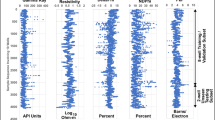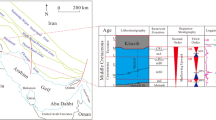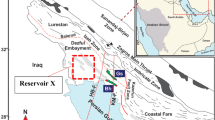Abstract
The exploration of carbonate rocks has outstanding economic benefits, as well as facing the extreme challenge of reservoir characterization. This article has proposed a data-based description scheme generalizing carbonate pore-type characteristics from both laboratory measurements and theoretical predictions to the well logging dataset. Firstly, in the feature space of elastic properties, we employed the supervised machine learning (ML) algorithm to convert this pore-type classification process from a typical nonlinear inversion to sample label allocation problem. Secondly, to alleviate the inherent scale gaps between data sources, virtual samples were randomly mixed into the laboratory measured dataset. Through inheriting or mimicking statistical elastic features of limited core samples, the new built training dataset could improve the overall sample richness and thus help the ML algorithms making better identification decisions. On the one hand, this scheme was verified by 74 carbonate samples. In the feature space of high dimensions, the blended dataset trained radial basis function support vector machine accurately separated different carbonate pore systems. Moreover, using logging curves of a carbonate gas field, we verified the generalization capability of this scheme over unbalanced data scales. Searching skills were used to optimize model and classifier setups according logging curves of a specific interval. Finally, with the help of the vertical label distributions, logging elastic response modes and historical pore evolution footprints were further studied.

















Similar content being viewed by others
References
Avseth P, Mukerji T, Mavko G et al (2010) Rock-physics diagnostics of depositional texture, diagenetic alterations, and reservoir heterogeneity in high-porosity siliciclastic sediments and rocks—a review of selected models and suggested work flows. Geophysics 75(5):A31–A47
Baechle G, Colpaert A, Eberli G et al (2008) Effects of microporosity on sonic velocity in carbonate rocks. Lead Edge 27(8):1012–1018
Berryman JG (1995) Mixture theories for rock properties, rock physics and phase relations: a handbook of physical constants. Am Geophys Union 3:205–228
Berryman JG, Pride SR, Wang HF (2002) A differential scheme for elastic properties of rocks with dry or saturated cracks. Geophys J Int 151:597–611
Brigaud B, Durlet C, Deconinck JF et al (2009) Facies and climate/environmental changes recorded on a carbonate ramp: a sedimentological and geochemical approach on middle Jurassic carbonates (Paris basin, france). Sed Geol 222(3–4):181–206
Choquette PA, Pray LC (1970) Geologic nomenclature and classification of porosity in sedimentary carbonates. AAPG Bull 54(2):207–250
Cortes C, Vapnik V (1995) Support vector networks. Machin Learn 20(3):273–297
Dietrich R, Opper M, Sompolinsky H (2008) Statistical mechanics of support vector networks. Phys Rev Lett 82(14):2975–2978
Dou Q, Sun Y, Sullivan C (2011) Rock-physics-based carbonate pore type characterization and reservoir permeability heterogeneity evaluation, upper San Andres reservoir, Permian Basin, west Texas. J Appl Geophys 74(1):8–18
Eberli GP, Baechle GT, Anselmetti FS et al (2003) Factors controlling elastic properties in carbonate sediments and rocks. Lead Edge 22:654–660
Huang Q, Dou Q, Jiang Y et al (2017) An integrated approach to quantifying geological controls on carbonate pore types and permeability, Puguang gas field. China Interpret 5(4):1–49
Keys RG, Xu S (2002) An approximation for the Xu-white velocity model. Geophysics 67:1406–1414
Kumar M, Han DH (2005) Pore shape effect on elastic properties of carbonate rocks. SEG Tech Program Expand Abstr 24:1477
Kuster GT, Toksöz MN (1974) Velocity and attenuation of seismic waves in two-phase media, part 1, theoretical formulations. Geophysics 39:587–606
Li H, Zhang J (2010) Modulus ratio of dry rock based on differential effective-medium theory. Geophysics 75(2):N43
Li B, Shen H, Qu S et al (2018) Tight carbonate reservoir characterization based on the modified rock physics model. J Appl Geophys 159:374–385
Mollajan A, Memarian H (2016) Rock physics-based carbonate pore type identification using Parzen classifier. J Petrol Sci Eng 145:205–212
Nur AM, Mavko G, Dvorkin J et al (2000) Critical porosity, a key to relating physical properties to porosity in rocks. Lead Edge 17:878–881
Regnet JB, Robion P, David C et al (2015) Acoustic and reservoir properties of microporous carbonate rocks: Implication of micrite particle size and morphology. J Geophys Res 120(2):790–811
Sayers CM (2008) The elastic properties of carbonates. Lead Edge 27:1020–1024
Song C, Alkhalifah T (2020) An efficient wavefield inversion for transversely isotropic media with a vertical axis of symmetry. Geophysics 2020:1–51
Stadtmuller M (2019) Well logging interpretation methodology for carbonate formation fracture system properties determination. Acta Geophys 67(6):1933–1943
Sun Y (2004) Pore structure effects on elastic wave propagation in rocks: AVO modelling. J Geophys Eng 1(4):268–276
Vanorio T, Mavko G (2011) Laboratory measurements of the acoustic and transport properties of carbonate rocks and their link with the amount of microcrystalline matrix. Geophysics 76(4):E105
Weger RJ, Eberli GP, Baechle GT et al (2009) Quantification of pore structure and its effect on sonic velocity and permeability in carbonates. AAPG Bull 10(10):1297–1317
Xu S, Payne MA (2009) Modeling elastic properties in carbonate rocks. Lead Edge 28:66–74
Xu S, White RE (1995) A new velocity model for clay-sand mixtures. Geophys Prospect 43:91–118
Yin X, Hua S, Zong Z (2016) A decoupling approach for differential equivalent equations based on linear approximation. Oil Geophys Prospect 51(2):281–287
Zhang J, Li H, Yao F (2012) Rock critical porosity inversion and S-wave velocity prediction. Appl Geophys 9(1):57–64
Zhao L, Nasser M, Han D (2013) Quantitative geophysical pore type characterization and geological implications in carbonate reservoir. Geophys Prospect 61(4):827–841
Acknowledgements
This article is supported by the Scientific Research Programs granted by the Department of Science and Technology of Jilin Province, China (grant No. 20190103140JH).
Author information
Authors and Affiliations
Corresponding author
Additional information
Communicated by Michal Malinowski (CO-EDITOR-IN-CHIEF)/Jadwiga Anna Jarzyna, prof (ASSOCIATE EDITOR).
Appendix: Equivalent elastic modulus of multiple pore-type materials
Appendix: Equivalent elastic modulus of multiple pore-type materials
Assume n = Km/Gm and m = n(P*i − Q*i). Polarization factors P and Q are decomposed as primary and secondary terms P0(n), Q0(n) and P1(m, n) depending on n and (m, n). For penny-shaped pores, Li and Zhang (2010) proofed parameter m satisfying
Hence, decoupled DEM solution of dry rock matrix bulk and shear moduli is
Transforming Eq. 13 to a first order Taylor expansion, we get
Now, considering N components pore system, we use a continuous division process replacing host modulus by last porous matrix modulus from i = N to 1. The bulk modulus K*i is derived from K*i−1,
Shear modulus can be derived in the same way. Therefore, we get a decoupled DEM solution for the multiple pore-type materials (i.e., carbonate rocks)
Rights and permissions
About this article
Cite this article
Li, B., Si, W., Shen, H. et al. Building the carbonate pore-type classifier for well logging via the blended training dataset. Acta Geophys. 69, 77–94 (2021). https://doi.org/10.1007/s11600-020-00516-y
Received:
Accepted:
Published:
Issue Date:
DOI: https://doi.org/10.1007/s11600-020-00516-y




